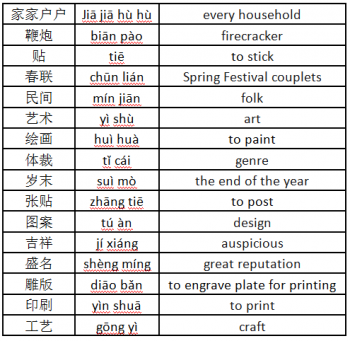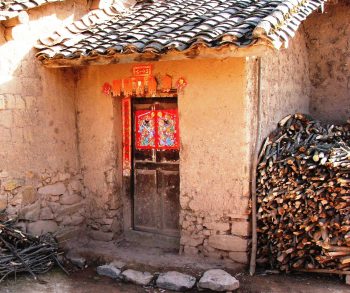Chinese Folk Art: New Year Paintings Posted by Ayana on Feb 4, 2019 in Culture
Chinese New Year will be celebrated this year on February 5th.
Chinese New Year (春节, chūn jié, literally means “spring festival”) has a lot of customs: New Year dinner, firecrackers, spring festival couplets, dumplings, and red envelopes, just to name a few. Among them is also the custom of hanging New Year paintings 年画 (nián huà).
年 (nián) = year
画 (huà) = painting
年画 (niánhuà) = New Year paintings
New Year paintings are a form of antique folk art that became a New Year tradition. It appeared in literature for the first time during the Song dynasty (960–1279 CE), but some believe it originated much earlier. The paintings are festive, and used as decoration for the house, but their original purpose was to ward off evil spirits. During ancient time they were called 门神画 (mén shén huà). 门神 are door gods and they were frequently the focus of the New Year paintings. They were hung on doors and entrances to protect the house from ominous spirits.
门 (mén) =door
神 (shén) = god, spirit
门神画 (mén shén huà) = door gods paintings
At the beginning of a new year people wish for more than just driving away demons. They pray for rain and a good harvest, and wish for wealth and good luck. Naturally the content of New Year paintings diversified. A famous painting, for example, is called 一团和气 (yī tuán hé qì). 一团和气 is a round portrait of the smiling Chenghua Emperor from the Ming dynasty, representing harmonious and peaceful coexistence. During the Qing dynasty the auspicious decorative paintings reached their peak. Paintings with historical stories, myths and legends, opera figures, and romance novels prevailed on doors in cities and country sides around China.
The classical paintings are manually printed on wood blocks. They are called 木版年画 (mù bǎn nián huà), and their manufacturing composed of three steps: sketching the paint on paper, painstakingly engraving it on several wood blocks (one for each of the colors appearing in the painting), and then printing it to a rice paper with different brush for every wood block. The delicate outcome is worth the long process. Watch the process of making these woodcuts:
https://www.youtube.com/watch?v=p7VpQH7jEB0
Try to read this short text about 年画. Assist the vocabulary list if you need.
春节是中国人最重要的节日。在过年的时候家家户户放鞭炮,贴春联,吃年饭。还有一项重要的事情,就是贴年画。年画是中国民间艺术之一,始于古代的“门神画”。年画是中国特有的一种绘画体裁。每值岁末中国人有张贴年画的习俗。家家户户都要贴上喜庆图案的年画,寓意吉祥幸福。木版年画最负盛名。木版年画源于宋代的雕版印刷工艺。
Chūn jié shì zhōng guó rén zuì zhòng yào de jié rì. Zài guò nián de shí hòu jiā jiā hù hù fàng biān pào, tiē chūn lián, chī nián fàn. Hái yǒu yī xiàng zhòng yào de shì qíng, jiù shì tiē nián huà. Nián huà shì zhōng guó mín jiān yì shù zhī yī, shǐ yú gǔ dài de “mén shén huà”. Nián huà shì zhōng guó tè yǒu de yī zhǒng huì huà tǐ cái. Měi zhí suì mò zhōng guó rén yǒu zhāng tiē nián huà de xísú. Jiā jiā hù hù dōu yào tiē shàng xǐ qìng tú àn de nián huà, yù yì jí xiáng xìng fú. Mù bǎn nián huà zuì fù shèng míng. Mù bǎn nián huà yuán yú sòng dài de diāo bǎn yìn shuā gōng yì.

好好学习,天天向上!

Build vocabulary, practice pronunciation, and more with Transparent Language Online. Available anytime, anywhere, on any device.





Leave a comment: